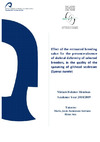Please use this identifier to cite or link to this item:
http://hdl.handle.net/10553/75529
| Title: | Effect of the estimated breeding value for the presence-absence of skeletal deformity of selected breeders, in the quality of the spawning of gilthead seabream ("Sparus aurata") | Authors: | Bolaños Mendoza, Miriam Esther | Director: | Zamorano Serrano, María Jesús Hyun Suk Shin |
UNESCO Clasification: | 251092 Acuicultura marina | Keywords: | Gilthead sea bream Deformity Spawning Survival Hatching rate |
Issue Date: | 2019 | Project: | Consumer driven Production: Integrating Innovative Approaches for Competitive and Sustainable Performance across the Mediterranean Aquaculture Value Chain Mejora de la Competitividad Del Sector de la Dorada A Través de la Selección Genética (Progensa-Iii) MELUSA |
Abstract: | Skeletal deformities are a major problem in the culture Industry of Gilthead Seabream because their variable incidence obligate the Aquaculture companies to oversize their productions in order to cover the market demand, increasing the production costs. Genetic effects of skeletal deformities in Seabream have been reported by segregation through on descendants, mass spawning at industrial scale and quantitative traits loci (QTLs) with microsatellites markers. Starting from this information, this work aims to study the determination the genetic selection effect for the presence-absence of deformity in the spawning quality of the Gilthead Seabream and to study the framework of development in which the different genetic cross of breeders selected for skeletal deformities by estimated breeding values (EBV) and consanguinity (a). At first, EBV of breeders coming from PROGENSA Breeding Program (for fast growth and low prevalence of skeletal deformities), to establish directed crosses according to their genetic prevalence (Deformed-Deformed and Normal-Normal). For this study, we evaluated quantity and quality (hatching rate and survival) of spawning in each crosses based on genetic prevalence. As a result, the average number of total eggs in DxD and NxN is 8,346 and 38,071, respectively, and the NxN group is greater than DxD with 4.6 times. Therefore, we hypothesized that deformity animals are evaluated with the genetic value that reduces the number of eggs spawned and quality (hatching and surviving), in addition, lower animal production. These data could be initial baseline data to support identification of genes related to the presence-absence of deformities and determine the stage of development of larvae to the prevalence of deformity. | Department: | Departamento de Patología Animal, Producción Animal, Bromatología y Tecnología de Los Alimentos | Faculty: | Facultad de Ciencias del Mar | Degree: | Grado en Ciencias del Mar | URI: | http://hdl.handle.net/10553/75529 |
| Appears in Collections: | Trabajo final de grado Restringido ULPGC |
En el caso de que no encuentre el documento puede ser debido a que el centro o las/os autoras/es no autorizan su publicación. Si tiene verdadero interés en el contenido del mismo, puede dirigirse al director/a o directores/as del trabajo cuyos datos encontrará más arriba.
Show full item recordPage view(s)
47
checked on Sep 9, 2023
Download(s)
19
checked on Sep 9, 2023
Google ScholarTM
Check
Share
Export metadata
Items in accedaCRIS are protected by copyright, with all rights reserved, unless otherwise indicated.
